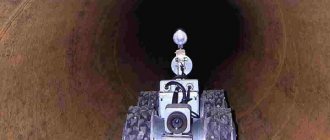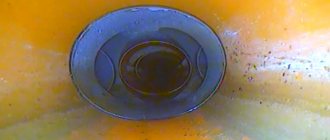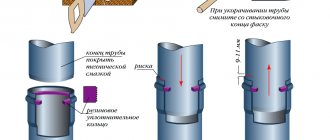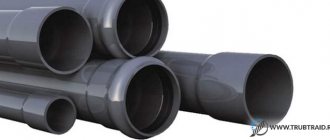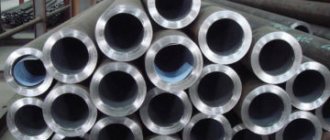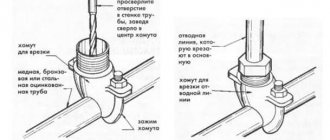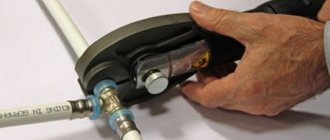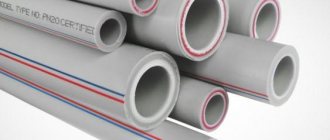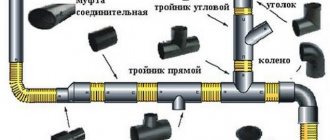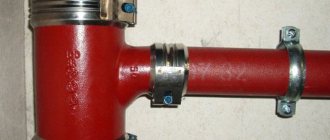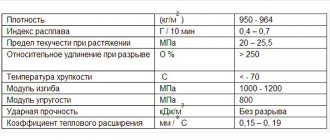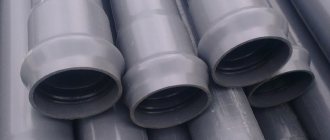Where are socket structures used?
Pipelines, the elements of which are joined using expansion funnels, are most often used to transport process water and sewage through internal and external networks.
Their installation requires minimal costs, and the method is simple. Therefore, such structures are important in servicing industrial and civil construction projects:
- residential buildings and industrial buildings,
- hydraulic structures.
In addition, socket joints are used in agriculture and to protect electrical cables from damage. There are several types of such products.
Sewer pipe caulking method
To perform caulking, you need to prepare a list of materials:
- cement mixture or parts thereof;
- fabric pieces or linen seal;
- funnel;
- chisel;
- utensils for mixing cement mortar.
Installation using the caulking method is very labor-intensive and is carried out in a certain order:
- Measure the length of the bell that needs to be transferred to the flat end of the other product by placing a notch.
- Wrap a piece of fabric or linen sealant at a distance of up to 30 mm from the mark towards the near end of the pipe. In this case, it is necessary to maintain a length of up to 30 mm from the winding to the edge of the product.
- Insert the wrapped part of the pipe into the funnel-socket and compact the seal using a chisel.
- Mix water with PVA glue in a prepared container and add cement. When working in an open space in winter, it is necessary to add a small amount of salt to the solution.
- Pour the resulting solution using a funnel into the gap at the bell extension.
- Leave the cement mixture to harden for 24 hours.
- If there is a clear need to use auxiliary sealing of the joint in the form of welding or tape sealing.
Thus, having carefully studied the main options for joining socket pipes when installing a sewerage system, you can choose the most suitable one for your home conditions, taking into account the cost of raw materials, labor intensity and complexity. When choosing a method, the type of material from which the drainage system pipes are made is of great importance.
Types of sockets for sewerage
Sewer socket pipes correspond to the material of the pipelines on which this expansion is installed.
Most often, concrete pipes are used for socket connections. They are durable and easy to install. The end inserted into the extension is compacted with a mixture of concrete and resin components.
Rubber rings can be used as a sealant to ensure the tightness of the joints.
Concrete structures with expansion funnels are used for laying external sewer networks. They are characterized by large sizes, ensuring the passage of large volumes of wastewater.
Indoors, sewerage and water pipes are installed from cast iron or plastic sewer pipes. Regardless of the type, pipes equipped with extensions for joining are mounted against the direction of fluid movement.
Socketless pipe structures
Sometimes, due to the design features of the pipeline or installation conditions, a socket pipe is not required. Most often, such situations arise during the construction of non-pressure sewer systems.
Flanges are used as connectors for concrete pipes, and clamps for cast iron pipes. If these connectors are sealed with cuffs, then the joints will be able to ensure high-quality operation of pressure systems.
Features of concrete sockets
The concrete pipe with a socket is manufactured in large sizes - 5 meters long, with an internal diameter of 1 meter and a wall thickness of 75 millimeters. Such dimensions ensure the strength and long service life of concrete structures.
They are used for sewerage, storm drains, and water transportation under roads.
For installation of industrial facilities, three types of sockets are produced - T, TB and TV. Each of them has characteristic features.
Type T includes sockets for the installation of non-pressure structures laid both underground and on its surface. They carry large volumes of wastewater or other liquids, the chemical composition of which cannot destroy the pipeline material. The popularity of this type is due to its low cost and ease of installation.
The TB category includes products for working under increased loads. Sewer collectors are installed from them. The kit includes rubber seals to improve the quality of sealing of joints.
The third type (TV) includes pipes for creating passages under roads.
The connections are sealed by rubber inserts, and the entire structure is able to withstand the weight of the soil above it, the road surface and passing vehicles.
The manufacturing technology is based on enhancing the strength of concrete with reinforced mesh. Therefore, their estimated service life is 50 years. This advantage, as well as the low price, contribute to the choice of concrete sockets by construction companies for assembling sewer networks. Such structures are not used at home.
Sockets made of cast iron and plastic
Since socket joints of pipes made of plastic and cast iron are destroyed when the liquid in them freezes, such products are used for the construction of drainage networks indoors.
Cast iron pipes are susceptible to corrosion and therefore require waterproofing, which leads to additional costs. Heavy weight also affects the scope of application of these products.
These shortcomings have led to the replacement of cast iron pipelines with plastic ones. The latter have one drawback - they are easily damaged mechanically.
In all other respects, plastic pipes are in no way inferior to cast iron pipes and even surpass them in that they are not susceptible to corrosion. Rubber rings are used as joint sealants.
Methods for installing sockets of each type have their own characteristics.
Pre-installation preparation of cast iron pipes
As mentioned above, due to the large weight of cast iron products, their delivery to the job site and assembly are significantly difficult. Therefore, and also for the purpose of safe and long-term operation of the equipped pipeline, before starting work with the products, it is necessary to check them for all kinds of defects.
In addition, the material is highly fragile, so even dropping the product from a small height can damage it irreparably.
To eliminate such factors, before starting work you need to:
- inspect the ends and sockets of the products, noting the presence or absence of irregularities;
- check that there are no significant variations in diameter along the length of the pipe;
- evaluate how good the bitumen coating is - it should be smooth, uniform, and not become sticky even at elevated temperatures;
- tap the products along the entire length, making sure that the sound is uniform and thick;
- make sure that all auxiliary materials (cement, tow, etc.) are prepared before starting work.
Installation
Installation using socket technology is suitable for steel, cast iron, ceramic, PVC and combined plastic pipes. Pipe sockets are joined in different ways. To seal plastic joints, rubber rings or glue are used; for cast iron, welding and caulking are used; for ceramic ones, only caulking is used.
Polymer materials
The easiest way to seal the joints of socketed plastic pipes is with rubber rings. If the extension has a special groove, then a ring is inserted into it. You should first make sure there is no damage and elasticity of the gasket. After this, the straight end is smoothly inserted into the sealing ring until it stops. This is how the entire section of the pipeline is installed.
If there is no groove for the ring in the expansion funnel, the joint is sealed with glue or sealant. To do this, first clean the smooth end with coarse sandpaper and apply an adhesive to it, 2 cm from the end. After the glue begins to harden, the pipe is inserted into the funnel and wait until it dries completely. After this, the next sewer unit is assembled.
Pros and cons of cast iron sewer pipes
Main advantages of the material:
- versatility - products are suitable for all soil types and most types of sewerage;
- resistance to changes in external temperature - cast iron pipes normally withstand both sudden and seasonal changes;
- long service life with proper assembly and installation of structures;
- a wide range of diameters of sewer cast iron pipes, allowing you to easily select products for your project;
- non-flammability;
- environmentally friendly - the material contains only iron and carbon, which, unlike plastic, guarantees the absence of harmful emissions into the atmosphere and the possibility of complete recycling of products;
- excellent noise reduction - also distinguishes cast iron pipes from products made from high-molecular compounds;
- relative chemical resistance;
- low susceptibility to corrosion, which allows you to not think about repairing the pipeline for a long time.
The product also has significant disadvantages:
- significant weight of sewer cast iron pipes, complicating their transportation to the place of work and all stages of pipeline assembly;
- increased fragility combined with a lack of ductility, which makes products unstable to dynamic mechanical overloads;
- the need to use additional materials when arranging the system;
- relative high cost of products;
- complexity and cost of repairs.
Since pipes are produced by casting, checking for cracks, cavities and other defects is quite simple: you need to carefully tap the product along its entire length, making sure that the sound is loud and uniform. It is recommended to tap both each individual element and the assembled structure.
Types of connection
There are several docking methods. Thanks to a wide range of options, it becomes possible to select the most suitable method, taking into account the operating conditions of the pipeline. Overview of connection types:
- Trumpet. Communications in this case have an expansion on one side. It resembles a cuff. A rubber gasket is installed in the socket. Then a pipe is inserted into this expansion. The result is a reliable, durable connection. However, its quality is determined by the characteristics of the gasket. If the rubber becomes deformed or loses its properties, which often happens during long-term use, a leak will form. It can be eliminated by replacing the gasket.
- Sealing method. In this case, communications with a socket are used, but the gasket is not installed at the joint. The cracks are filled with tow and then cemented.
- Socketless connection. In this case, an adapter in the form of a coupling is used. Communications are installed into this product on both sides. Then, in this section, the pipeline elements are tightened using metal clamps.
- Plastic docking. Docking according to this principle is performed when it is necessary to connect sections of cast iron and plastic pipelines. For this purpose, special adapters and sealant are used.
What is a collet fitting
To understand this issue, you need to understand the definition of two terms: collet and fitting.
There is an abundance of fittings made from different materials on the market
plastic, copper, steel, etc.
They can be used both for the simple connection of two tubes of the same diameter, and as adapters between pipes of different diameters, different materials (for example, the transition from metal-plastic), to perform the functions of tees, crosses, corners, plugs, etc.
Thanks to the collet fixation of the fitting, such a connection does not require special knowledge,
tools or large physical costs. But at the same time, connections made using this method are sealed and durable.
- collet fittings can be used in the installation of pipelines transporting hot and cold water, gases, oils, and chemical media;
- the temperature of the transported medium should not exceed 175ºC;
- permissible pressure does not exceed 1.6 MPa;
- the internal diameter of clamp connectors for plastic, metal-plastic or copper pipes presented on the construction market varies from 8 to 100 mm;
- collet fitting can be straight, angled, tee, cross, etc.
Types of collet fittings
- straight collet fitting or coupling. This type is used to connect pipe sections of the same diameter from the same material;
- a transition fitting is required if it is necessary to connect pipes of different diameters or to transition between pipes made of different materials (for example, connecting metal-plastic and metal pipes);
- A corner or outlet connector is used to arrange corners and turns from 45 to 120 degrees;
- cross - an element that allows in two directions;
- a tee is used if a one-way branch from the flow is necessary;
- the fitting serves as an adapter from pipe to hose;
- needed to shut off the flow at the end of the pipeline.
Advantages and disadvantages
The push-in fitting is the most popular connecting element.
This is due to a number of its undeniable advantages:
- affordable price;
- wide range of models;
- Availability of any specialized stores in the assortment;
- ease of installation work that every consumer can handle;
- the possibility of installation using improvised means without purchasing any special equipment;
- tightness and high reliability of joints of metal-plastic, plastic or copper pipes;
- durability;
- Possibility of reusing connecting elements. Thanks to this, collet fittings are convenient to use even in temporary structures;
However, there are some disadvantages:
over time, the clamp of the collet weakens, so there is a need to periodically tighten the clamping nut; the consequence of the first drawback is a categorical ban on embedding collet connectors in walls
They must be available for preventive maintenance and repair at all times; Installation of collet fittings, although it does not require special knowledge and skills, does require intelligence and caution. They need to be tightened sensitively so that the collet or nut does not crack (this is especially true for plastic connectors).
